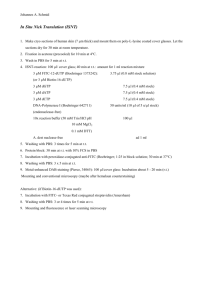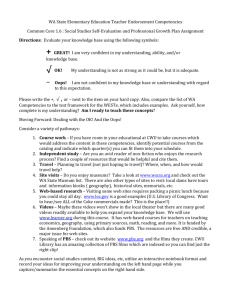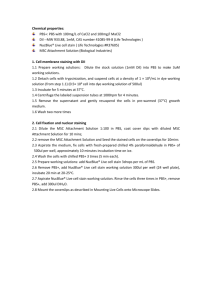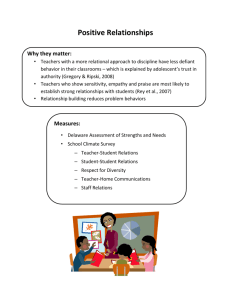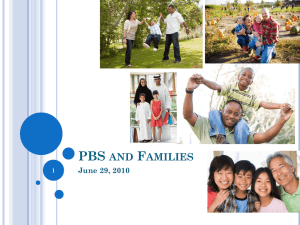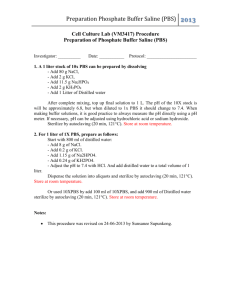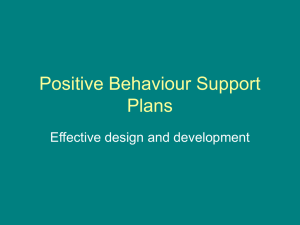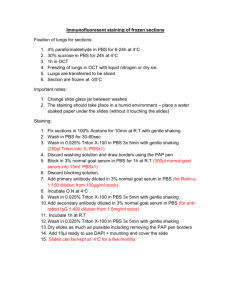PPT - Florida`s Positive Behavior Support Project
advertisement
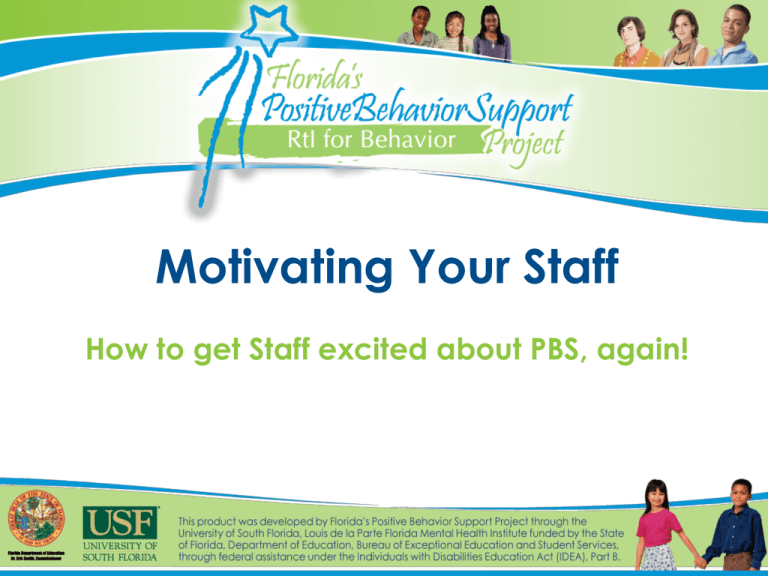
Motivating Your Staff How to get Staff excited about PBS, again! Are you experiencing this? Staff’s Level of Excitement November October Septemeber 5 4 3 2 1 Bump on 0 a Log August Dancing in the halls 6 2 Is This Your School? • Teaching has lost its joy and been replaced with “just a job” mentality • Students come to school to watch teachers work • Parents and teachers look for excuses & participate in the blame game • Staff feels isolated & has no time for social interaction • People cannot wait until retirement (even when they have 12+ years left) (C. Wagner, 2004) 3 What is School Culture? • The “beliefs, attitudes, and behaviors that characterize a school in terms of: – How people treat and feel about each other; – The extent to which people feel included and appreciated; and – Rituals and traditions reflecting collaboration and collegiality.” (Gary Phillips, 1993) • Link between a school's culture and student achievement, staff satisfaction, and morale. (Center For Improving School Culture, Bowling Green, KY) 4 Think About It • What kind of a culture will a school develop if it is not actively addressed? If the fish in your aquarium are sick, do you blame the fish? Maybe you should check the water? 5 Features of School Culture 1. Collaboration = the degree in which people work together, share information, and are involved in productive discussions and debates. 2. Collegiality = a sense of belonging, emotional support, and inclusion as a valued member of an organization. 3. Organizational Structures = the traditions and rituals that effect the everyday lives of ALL those involved 6 Collaboration: Working Together •Buy-in and Ownership •Training: Critical Elements •Creative Ideas 7 Buy-in and Ownership • Achieving Buy-in is a continuous process – Kick-off Activities = • Open lines of communication between staff & PBS Team • Introduce Critical Elements • Detail Critical Elements to be implemented this school year • Share Draft of PBS School Manual • Train Small Groups & Large Groups • When? Early release days, faculty meetings, grade level team meetings, & planning periods • Give information in short bursts, do not overload • Implement items that will result in early, small-scale success 8 Creative Kick-Off Ideas • Theme Activities: Rain Forest; Mind-Body-Soul; Baby Gator Shower • Role Plays − − − − Before vs. After PBS Expectations & Rules: Examples & Non-examples Referral Process Giving a consequence and giving positive reinforcement • Watch a video & have staff fill out referral form – Staff critique referral forms turned in 9 Ongoing Buy-In & Participation • Group-Developed Lesson Plans • Activities from Summer Training: – – – – School Dream, Ideal Student, Definitions of Appropriate Behavior, Classroom Interventions, Referral Process • Replace One Faculty Meeting with a Collaboration Time – “Data Walk” 10 Collegiality •Morale Building Activities •Team Building Activities 11 Moral-Building Activities • Develop feelings of belonging by taking time out for morale-building activities – Initial Activities = • Open lines of communications • Give time for question & answer at trainings • Introduce all PBS team members & give contact information • Have open PBS Team Meetings, anyone can join if they have information to add 12 Moral-Building Activities • Provide special awards linked to PBS achievement (class with 100% attendance, etc) • Quote of the day • Give out a strategy of the day: 2 ways to incorporate the expectations into your lesson plans • Create and give out positive office referrals 13 Moral-Building Activities • Have all faculty names placed in a hat. Everyone draws a name and has to decorate a “medal” (paper plate) for that person. • Celebrate Individual Staff: – Let Denise know she is special today – I Appreciate __Sandra_____ Because: • We think alike • Have the same taste in music • She is open and honest – White T-shirt Activity – Name Poem 14 Team Building Activities • Scavenger Hunt • Teams of two: 1 person Blindfolded, 2 person gives 1 person a set of instructions on how to build a structure out of spaghetti noodles and marshmallows • What have we got in common? (The team lists all the things that the whole team has in common) • http://www.teampedia.net/wiki/index.php?title=Main_Page (Back 2 Back Drawing, Impersonation, Thumper, Soap Opera Names, Family Feud) • Obstacle course (Hola Hoop, Hopscotch, Move an egg with a spoon, Hit a Golf Ball Into a Cup) • Team Trivia 15 Creative Ideas • “Don is Special” Day! – Create posters and hang all over campus – Create stickers to wear on your shirt – Send random emails • “Guess Who?” Have each staff member write a paragraph about themselves. One time week send it out over email and have staff guess who it is. 16 Organizational Structures •Assessing Your School 17 Assessing Your School • You can identify the behavioral expectations within 5 minutes of entering the school – Posters are everywhere (halls, classrooms, etc) – Hear faculty using a common language – See it being referred to during instruction • Students state the behavioral expectations – Ask 10 randomly selected students (ask from different age, gender & ethnic groups) • Students are recognized for appropriate behavior – Ask 10 randomly selected students if they have been acknowledged for appropriate behavior in past week – Note if you see all faculty given out any school-wide tokens 18 Assessing Your School • Faculty, staff & families know behavioral expectations – ALL Faculty & staff know expectations – Substitute teachers know expectations – Families know expectations • Student to Student interactions reflect expectations – Students prompt and support behavioral expectations • Physical environment is cared for • Students approach adults 19 FISH! A Remarkable Way to Boost Morale and Improve Results Stephen C. Lundin Harry Paul John Christensen 20 4 Ingredients to an Energy-Filled Workplace 1. Choose Your attitude 2. Play 3. Make their Day 4. Be present 21 CHOOSE YOUR ATTITUDE! • Most of us believe our attitudes are caused directly by outside influences like unpleasant experiences or negative people. But while external pressures may trigger our feelings, we are the ones wearing those feelings like a suit of clothes. • When you are doing what you are doing, who are you being? – Are you being impatient and bored OR are you being WORLD FAMOUS! – Who do you want to be at work? – Ask yourself, is my attitude helping me/others? 22 Choose Your Attitude Energetic Angry Caring Disinterested Vital Bitter 23 PLAY! • People who find ways to incorporate “play” into their daily lives approach their work, responsibilities and challenges with energy and enthusiasm. • Playful work we do allows us to find creative ways to engage our students • If we don’t find constructive ways to meet students’ universal need for fun, students’ will devise their own, not-so-constructive ways (Kriete, R. 2003) 24 MAKE THEIR DAY! • Look for as many ways as you can to create great memories! • It moves past just being civil or pleasant—it’s taking that extra step you didn’t have to take. And that makes all the difference. • Teachers who had high quality relationships with their students had 31% fewer discipline problems. (Marzano, R.J. and Marzano, J.S. 2003) 25 BE PRESENT! • Being “present” for another person has a powerful effect. Think about how good it feels when someone gives you her or his undivided attention, focusing on your needs and feelings. Now think about how it feels when someone with whom you are “interacting” barely looks at you. – Actively listen (suspend judgment, don’t think about the comeback) – Talk to me like I was your long lost friend 26 In The Right Environment, They Bloom Like Crazy! 27 Join Us Again! Next Chat: Wednesday, February 9th 2:30-3:30 EST Topic TBD Ideas for February’s topic? Please type them in! 28 PBS:RtIB Contact Information & Resources FLPBS:RtIB Project – Phone: (813) 974-6440 – E-mail: flpbs@fmhi.usf.edu – Website: http://flpbs.fmhi.usf.edu OSEP Center on PBIS – Website: http://www.pbis.org 29

